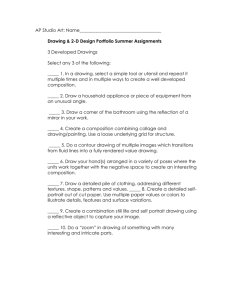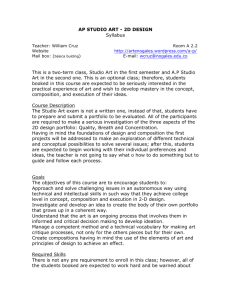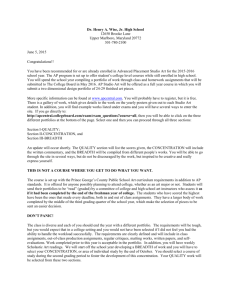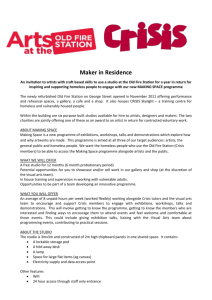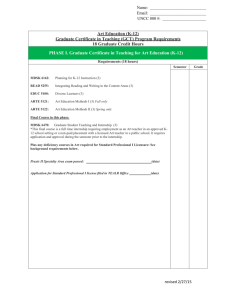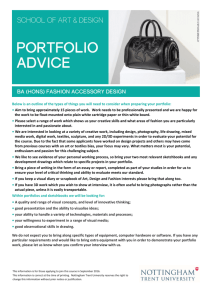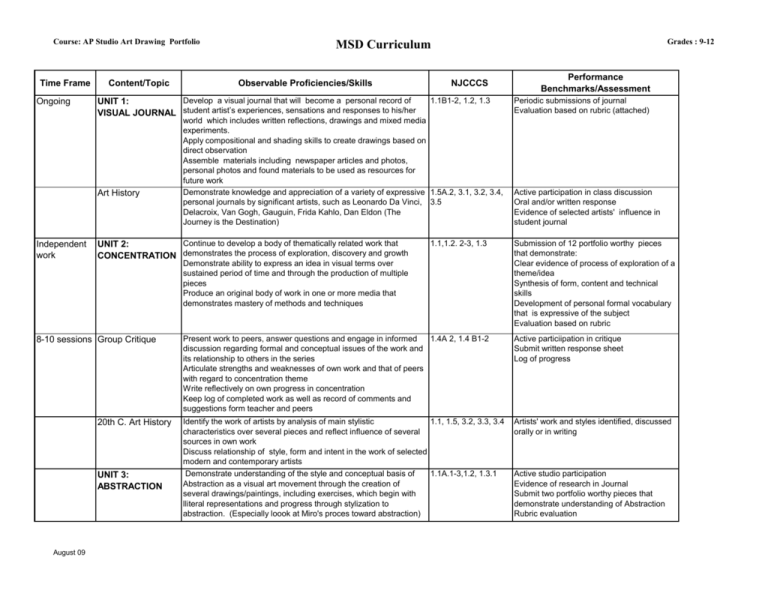
Course: AP Studio Art Drawing Portfolio
Time Frame
Ongoing
Content/Topic
Independent
work
Observable Proficiencies/Skills
Develop a visual journal that will become a personal record of
UNIT 1:
VISUAL JOURNAL student artist’s experiences, sensations and responses to his/her
Art History
Grades : 9-12
MSD Curriculum
NJCCCS
1.1B1-2, 1.2, 1.3
world which includes written reflections, drawings and mixed media
experiments.
Apply compositional and shading skills to create drawings based on
direct observation
Assemble materials including newspaper articles and photos,
personal photos and found materials to be used as resources for
future work
Demonstrate knowledge and appreciation of a variety of expressive 1.5A.2, 3.1, 3.2, 3.4,
personal journals by significant artists, such as Leonardo Da Vinci, 3.5
Delacroix, Van Gogh, Gauguin, Frida Kahlo, Dan Eldon (The
Journey is the Destination)
Continue to develop a body of thematically related work that
UNIT 2:
CONCENTRATION demonstrates the process of exploration, discovery and growth
1.1,1.2. 2-3, 1.3
Demonstrate ability to express an idea in visual terms over
sustained period of time and through the production of multiple
pieces
Produce an original body of work in one or more media that
demonstrates mastery of methods and techniques
8-10 sessions Group Critique
20th C. Art History
UNIT 3:
ABSTRACTION
August 09
Performance
Benchmarks/Assessment
Periodic submissions of journal
Evaluation based on rubric (attached)
Active participation in class discussion
Oral and/or written response
Evidence of selected artists' influence in
student journal
Submission of 12 portfolio worthy pieces
that demonstrate:
Clear evidence of process of exploration of a
theme/idea
Synthesis of form, content and technical
skills
Development of personal formal vocabulary
that is expressive of the subject
Evaluation based on rubric
Present work to peers, answer questions and engage in informed
1.4A 2, 1.4 B1-2
discussion regarding formal and conceptual issues of the work and
its relationship to others in the series
Articulate strengths and weaknesses of own work and that of peers
with regard to concentration theme
Write reflectively on own progress in concentration
Keep log of completed work as well as record of comments and
suggestions form teacher and peers
Active particiipation in critique
Submit written response sheet
Log of progress
Identify the work of artists by analysis of main stylistic
1.1, 1.5, 3.2, 3.3, 3.4
characteristics over several pieces and reflect influence of several
sources in own work
Discuss relationship of style, form and intent in the work of selected
modern and contemporary artists
Demonstrate understanding of the style and conceptual basis of
1.1A.1-3,1.2, 1.3.1
Abstraction as a visual art movement through the creation of
several drawings/paintings, including exercises, which begin with
lliteral representations and progress through stylization to
abstraction. (Especially loook at Miro's proces toward abstraction)
Artists' work and styles identified, discussed
orally or in writing
Active studio participation
Evidence of research in Journal
Submit two portfolio worthy pieces that
demonstrate understanding of Abstraction
Rubric evaluation
Course: AP Studio Art Drawing Portfolio
Modern and
Contemporary Art
Critique
Create a reductive series of drawings showing the progressive
stages of the deconstruction of an image (of object/s, figure/s or
place) from objective rendering to a composition or design based
on the subject's essential characteristics and structure.
As above
For example:
Create series of 3 super cropped, detailed bicycle drawings
Progression based on multiple photos of a single object - medium
of choice
Skillfully manipulate elements and principles of design to express
a conceptual issue in a 2-D work of art in medium of choice.
As above
1.1B.1., 1.2.1,
1.2.2,1.2.3,
1.3.1,1.4A.1
As above
For example :Translate information to a visual representation of that
information (eg., a map, chart, diagram).
Create an abstract or semi-abstract composition utilizing the
principles of repetition, rhythm, variety, unity to organize slected
elements. ("Constellations')
Demonstrate understanding of the theory and development, in
1.1A.2-3, 1.4, 1.5A 1,
historical as well as in contemporary manifestations of Abstraction 3.1, 3.2, 3.3, 3.4, 3.5
as a visual art movement through participation in presentation
discussion and research. (Miro, Mondrian, Hoffman, Diebenkorn)
As above
Determine the value of works of art based on craftsmanship,
originality and stated objectives
Participation in class critique using
appropriate terminology based on rubric
1.4A2-3,1.3.1, 3.2,
3.3, 3.4
1.2.2, 1.2.3,1.3.1,
UNIT 4: STILL LIFE Select, research and simulate the work of 3 artists with differing
stylistic
approaches
to
the
genre
of
still
life
Object
Demonstrate the ability to distort, stylize, exaggerate forms, textures
Transformation
and space in several dynamic compositions in which negative
space is a key component.
For example: Using various methods of stylization of subject
matter and ground (or 2-D space):
Create a still life composition of highly reflective objects and
surfaces in which a reflection of student/artist is included
Create a still life of wrapped objects in an environment
Create a cubist still life after investigating the Cubist innovations of
various masters including(Picasso, Leger)
Create a composition based on a still life arrangement (actual or
from personal photo) in which colors and shapes are exaggerated
and stylized or distorted to become elements in a flattened space
as in Matisse. Negative space is an integral part of overall design
August 09
Grades : 9-12
MSD Curriculum
Active participation in discussion
Evidence of research in journal and in
artwork Written responses on exam
Active studio participation
Evidence of research and experimentation in
Journal
Two portfolio worthy pieces completed that
satisfy assignment objectives
Rubric self assessment
As above
Select and complete 2 out of 4 assignments
Course: AP Studio Art Drawing Portfolio
Demonstrate understanding of the work of selected artists who
1.1A.1,1.4A.2, 1.5B.1
explore similar issues in their work (such as: Audrey Flack, Janet
Fisch, Magritte, Picasso, Leger, Matisse, Hannah Hoch, Estes,
Morandi), through research materials in journal, oral and/ or written
discussions.
Articulate strengths and weaknesses of own work and that of peers 1.4B.1, 1.4B.2,
with regard to stated assignment objectives
Submit journal with research materials
Oral or written responses
UNIT 5:FIGURE
Demonstrate understanding of structure and proportion of human 1.2.2, 1.2.3,
figure in several gesture drawings/paintings from life Work from life
to produce figerative drawings which will serve as a resource for
artisitc products
Use elements and principles of design to express a mood and
1.2.2, 1.2.3, 1.3.1
describe an environment in a figural composition
Use mark making, gestural use of medium, and compositional
devices (such as perspective and cropping) to create a dynamic
composition of a figure(s): in motion, in context, in repose
Produce piece that combines photocopied body parts (hands, feet,
face) with anatomical drawings (APStudio Art:2D, Syllabus 1, the
College Board, ..)
Two or more gestural figure
drawings/paintings
Observational drawings produced from
multiple angles
Active studio participation
Evidence of research and experimentation in
journal
Work demonstrates unique expression of
personal voice
Submit 3 portfolio worthy pieces that satisfy
assignment objectives
Art History
Evaluate the impact of innovation in the arts from various historical 1.4.A1, 1.4.A.2,1.5B.2 Artists' work and styles identified, discussed
periods in works of art stylistically characteristic of the times.
orally or in writing
(Raphael. Rubens, Vuillard, Degas, German Expressionists,
Munch, Nolde,Picasso, Duchamp, Bacon, Freud, Giacometti,Neel,
Fischl)
Critique
Articulate strengths and weaknesses of own work and that of peers 1.4B.1-2
with regard to stated assignment objectives
Active participation in critique
UNIT 6:
SELF-PORTRAIT/
PORTRAIT
Explore many possible solutions to the problem of creating a self
1.1B.1, 1.2.1, 1.2.2,
portrait or portrait. Convey content by:
1.2.3, 1.3.1
using traditional artistic devices, such as emphasis on details,
posture, setting, accessories skillfully manipulatig medium,
technique, selected elements (such as value, color), and principles
of design to produce an expressive portrait
utilizing extreme perspective create a life size portrait utilizing non
traditional artistic devices such as fragmentation, distortion,
repetition, grid format, total abstraction, create a portrait that
communicates essential character or aspects of a personality.
Active studio participation
Evidence of experimentation in Journal
Three portfolio worthy pieces completed that
satisfy assignment objectives
Rubric self assessment
Art History
Critique
August 09
Grades : 9-12
MSD Curriculum
Active participation in class critique
Completion of rubric self assessment
Course: AP Studio Art Drawing Portfolio
Art History
Describe and interpret the individual manner in which selected
artists manipulate elements and apply principles of design and
specific techniques to convey meaning (for example:van Gogh,
Kahlo, Marsden Hartley, Kara Walker, Sikander, De Kooning,
Saville, Peyton, Giacometti, Francesca Woodman, Samaras,
Richard Hamilton, Oscar Bluemner, Rosenquist, Catherine
Opie(Whitney site)Lorna Simpson, Ellen Gallagher)
Critique
Articulate strengths and weaknesses of own work and that of peers 1.4B.1-2
with regard to stated assignment objectives
Active meaningful participation in critique
UNIT 7:
SPATIAL
INVESTIGATION
Landscape/Interior
Translate one or more personal landscape and/or interior photos
1.1B.1,
into 3 balanced, dynamic compositions
1.2.2,1.2.3,1.3.1,
Consciously utilize elements and principles of design to make
1.3.2 8.1.A
aesthetic decisions
Use various spatial systems to create and organize exterior/interior
subject matter and space on a 2D plane
Download, or scan, and print digital photos
Submit Journal with evidence of
planning(thumbnails), research, visual
references
and two finished works dealing with spatial
distortion
Examples:
Using surrealist devices create a land/city scape in medium(s) of
choice
Create a composition that combines real space and subject matter
with imagined space and subject matter
Create a composition or series that includes 3 different
views/versions of the same landscape/interior
Create a landscape/inerior of distorted, stylized and exagerrated
forms and space
Create a landscape/interior composition (painting, drawing, mixed
media) based on Rosenquist photomontage based paintings
(Chambliss, AP Studio Art, 2D)
As above
20th C. and
Contemporary Art
Critique
August 09
Grades : 9-12
MSD Curriculum
Identiy and describe technical/stylistic differences from among a
range of modern and contemporary painters presented
Articulate the relationship between expressive means and the intent
of the artist. (Cezanne, Matisse, Dali, De Chirico, Escher,
Picasso, Mondrian, Joseph Stella, Sheeler, Milton Avery, April
Gornick )
Articulate strengths and weaknesses of own work and that of peers
with regard to stated assignment objectives
1.4.A1, 1.4.A.2,1.5B.2 Evidence of research and visual references
in Journal
Artists' work and styles identified, discussed
orally or in writing
1.4.A1,
1.4.A.2,1.5.B.1,
1.5B.2
Evidence of research of selected artists work
in Journal
Submit Response Sheet on selected artists
1.4B.1, 1.4B.2
Participation in critique based on rubric
Course: AP Studio Art Drawing Portfolio
15 class
sessions
UNIT 8:
ILLUSTRATION
Visual Literacy/
Art Criticism
Grades : 9-12
MSD Curriculum
Through analysis and interpretation of professional exemplars,
identify compositional strategies artists use to communicate a
complex idea
1.1A.1, 1.1B.1, 1.2.1, Participation in discussion
1.2.2, 1.3.1, 1.3.2.2,
Apply above strategies in a series of timed exercises in which
students illustrate a given word, phrase, situation
1.1B.1,1.21,1.2.2,
1.3.1, 1.3.2
Plan individual illustration based on personal memory or current
experience by creating a series of thumbnail sketches in order to
arrive at dynamic compositon and clear communication of idea
Plan and execute an original illustration which conveys a coherent
message to the viewer and which will reproduce clearly
Apply strategies observed in professional examples to convey
meaning in a single strong image.
Select and utilize media for expressive potential
Demonstrate a developing personal style
Completed exercises
Submit for peer review
Multiple thumbnail sketches
1.1-1.3
Submit rough draft for review, Submit visual
references, submit finished illustration for
peer review - intended message clear to
majority of class members
Art History
Identify and articulate key aspects of styles of artist- illustrators such 1.4.A1,
as Maurice Sendak, N. C. Wyeth, Ralph Steadman, as well as the 1.4.A.2,1.5.B.1,
devices they used to convey intended meaning
1.5B.2
Completed response sheet/quiz
Critique
Articulate strengths and weaknesses of own work and that of peers 1.4B.1, 1.4B.2
orally and/or in writing
Participation in group discussions, written
responses, student created Power Point
presentations, or reports
On-going,
infused
throughout
UNIT 9:
CAREERS
Compare the relative merits of two or more colleges/art school
during presentations from reps.
Demonstrate understanding of various career paths open to art
students/graduates with BA or BFA through oral and written
responses
1.2.4,
Written respponse, comparison
Active participation in question and answer
session
Portfolio presentation
Note taking
Ongoing
UNIT 10:
PORTFOLIO
PREPARATION
Set up lights and tripod and operate SLR camera to produce
portfolio quality image for digital portfolio and for slides
Use aesthetic judgment to select strongest works for inclusion in
portfolio
Articulate formal and conceptual theme explored in Concentration
section in a cohesive, formal written statement
1.1.B.2, 1.4B.1, Tech All pieces successfully photographed Work
Ed
ranked using aesthetic judgment.
Reasons for final selection justified orally or
in writing
Written statement submitted
BIBLIOGRAPHY
Bayles, David &
Orland, Ted
August 09
Art & Fear, Observations on the Perils (and Rewards) of
Artmaking,(Image Continuum Press, 2001)
Course: AP Studio Art Drawing Portfolio
Betti, Claudia & Sale,
Teel
Davis, Maggie
MSD Curriculum
Drawing:A Contemporary Approach, (Wadsworth, 2004)
AP Studio Art Teacher's Guide:2-D Design, 3-D Design,
Drawing,(College Entrance Examination Board, 2003)
Drawing: Structure and Vision, (Pearson/Prentice Hall, 2009)
Drury, Fritz & Stryker,
Joanne
Eldon, Daniel & Kathy The Journey is the Destination: The Journals of Daniel Eldon
(Chronicle Books, 1997)
Hale, Robert B.
Drawing Lessons from the Great Masters, (Watson-Guptill, 1989)
Henry, Sara Lynn
Midnight Full of Stars, exhibition catalogue (NJCVA, 2008)
Kantor, Jordan
Drawing from the Modern: 1975-2005, (Museum of Modern Art,
2005)
The Art of Seeing, 7th ed,(Pearson/Prentice Hall, 2007)
Zelanski, Paul &
Fisher, Mary Pat
The College Board Pre-AP, The P Vertical Teams Guide for Studio
Art (College Entrance Examination Board, 2002)
AP Studio Art Exam Resources: 2007-2008 Professional Workshop
Materials (College Board Advanced Placement Program, 2007)
art:21, Art in the Twenty-First Century, PBS Home Video, Seasons
1-4
Websites:
http://hubblesite.org
http:www.astrographics.com/click on Gallery Prints,
www.space.com/
www.skyandtelescope.com
www.astronomy.com/
www.astronomy.com/asy/default.aspx
http://whitney.org/learning/research/lesson_plan
August 09
Grades : 9-12

